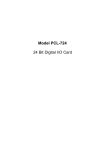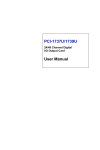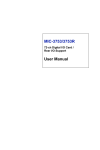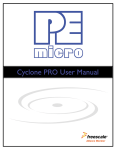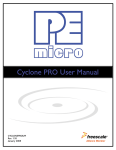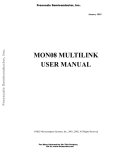Download 205k - Fairchild Engineering Ltd
Transcript
PCL-731 48-bit Digital I/O Card Copyright This documentation is copyrighted 1994 by Advantech Co., Ltd. All rights are reserved. Advantech Co., Ltd. reserves the right to make improvements in the products described in this manual at any time without notice. No part of this manual may be reproduced, copied, translated or transmitted in any form or by any means without the prior written permission of Advantech Co., Ltd. Information provided in this manual is intended to be accurate and reliable. However, Advantech Co., Ltd. assumes no responsibility for its use, nor for any infringements of the rights of third parties which may result from its use. Acknowledgments PC-LabCard is a trademark of Advantech Co., Ltd. IBM and PC are trademarks of International Business Machines Corporation. OPTO-22 is a trademark of OPTO-22 Corporation. Москва: Телефон: (095) 234-0636 (4 линии) Факс: (095) 234-0640 BBS: (095) 336-2500 Web: http://www.prosoft.ru E-mail: [email protected] Для писем: 117313, Москва, а/я 81 С.-Петербург: (812) 325-3790 Екатеринбург: (3432) 49-3459 Contents Chapter 1 General information ...................................................... 1 Introduction ....................................................................... 2 Features .............................................................................. 2 Applications ....................................................................... 2 Specifications .................................................................... 3 Connector pin assignments ............................................... 4 Block diagram ................................................................... 5 Chapter 2 Installation ....................................................................... 7 Initial inspection ................................................................ 8 Switch and jumper settings ............................................... 8 Chapter 3 Operation ........................................................................ 13 Configuration ................................................................... 14 Interrupt handling ............................................................ 17 Chapter 4 Programming .................................................................. 19 Demo programs ............................................................... 21 CHAPTER General Chapter 1 1 information General Information 1 Introduction The PCL-731 is a 48-bit DIO card. It provides you with 48 bits of parallel digital input/output and emulates mode 0 of the 8255 PPI chip. Buffered inputs and outputs offer a high driving capacity. The card’s 48 bits are divided into six 8-bit I/O ports: A0, B0, C0, A1, B1 and C1. You can configure each port as either input or output via software. The card also offers two hardware interrupt lines to the PC. The card offers two 50-pin OPTO-22 compatible connectors which can connect to a PCLD-7216 SSR I/O module carrier board, PCLD-885 power relay output board, PCLD-785B and PCLD7225 24/16-channel relay output boards or a PCLD-782B 24/16 channel opto-isolated D/I board. Features • 48 TTL digital I/O lines. • Emulates mode 0 of 8255 PPI • Interrupt handling • OPTO-22 compatible 50-pin connectors • Output status readback Applications • Industrial AC/DC I/O module monitoring and control • Relay and switch monitoring and control • Parallel data transfer • Sensing the signals of TTL, DTL, CMOS logic • Driving indicator LEDs 2 PCL-731 48 Bit Digital I/O Card User's Manual Specifications I/O address assignments Address Function BASE+0 PORT A0 BASE+1 PORT B0 BASE+2 PORT C0 BASE+3 CFG REG BASE+4 PORT A1 BASE+5 PORT B1 BASE+6 PORT C1 BASE+7 CFG REG Input signal • Logic high voltage: 2.0 to 5.25 V • Logic low voltage: 0.0 to 0.80 V • High level input current: 20 µA • Low level input current: -0.2 mA Output signal • Logic high voltage: 2.4 V Min. • Logic low voltage: 0.4 V Max. • High level output current: -15 mA Max. (source) • Low level output current: 24 mA Max. (sink) • Driving capacity: 15 LS TTL Transfer rate • Typical: 300 Kbytes/sec • Maximum: 500 Kbytes/sec Chapter 1 General Information 3 Power consumption • Typical: 0.5 A @ 5 VDC (±5%) Connector pin assignments The PCL-731 features two OPTO-22 compatible 50-pin connectors. Pin assignments are as follows: CN1 PC 07 PC 06 PC 05 PC 04 PC 03 PC 02 PC 01 PC 00 PB 07 PB 06 PB 05 PB 04 PB 03 PB 02 PB 01 PB 00 PA 07 PA 06 PA 05 PA 04 PA 03 PA 02 PA 01 PA 00 +5 V 1 3 5 7 9 11 13 15 17 19 21 23 25 27 29 31 33 35 37 39 41 43 45 47 49 2 4 6 8 10 12 14 16 18 20 22 24 26 28 30 32 34 36 38 40 42 44 46 48 50 CN2 GND GND GND GND GND GND GND GND GND GND GND GND GND GND GND GND GND GND GND GND GND GND GND GND GND PC 17 PC 16 PC 15 PC 14 PC 13 PC 12 PC 11 PC 10 PB 17 PB 16 PB 15 PB 14 PB 13 PB 12 PB 11 PB 10 PA 17 PA 16 PA 15 PA 14 PA 13 PA 12 PA 11 PA 10 +5 V 1 3 5 7 9 11 13 15 17 19 21 23 25 27 29 31 33 35 37 39 41 43 45 47 49 PCL-731 Block Diagram 4 PCL-731 48 Bit Digital I/O Card User's Manual 2 4 6 8 10 12 14 16 18 20 22 24 26 28 30 32 34 36 38 40 42 44 46 48 50 GND GND GND GND GND GND GND GND GND GND GND GND GND GND GND GND GND GND GND GND GND GND GND GND GND Block diagram Decoder I/O CKT Data Bus Address Bus Control Bus 8255 Port A0 Port B0 Port C0 Port A1 Port B1 Port C1 CN1 8 8 8 OPTO 22 Connector 8 CN2 8 OPTO 22 Connector 8 PC00 Interrupt Handling PC10 IRQ2 IRQ3 IRQ4 IRQ5 IRQ6 IRQ7 IRQ10 IRQ11 IRQ12 IRQ15 IRQ2 IRQ3 IRQ4 IRQ5 IRQ6 IRQ7 IRQ10 IRQ11 IRQ12 IRQ15 Chapter 1 General Information 5 6 PCL-731 48 Bit Digital I/O Card User's Manual CHAPTER 2 Installation Chapter 2 Installation 7 Initial inspection Before you install the PCL-731, first check to make sure it was not damaged during shipping. If you find any damage or the card fails to meet specifications, please contact your local dealer or sales representative. Also contact the shipper and save the shipping materials for the shipper's inspection. Switch and jumper settings We designed the PCL-731 with ease-of-use in mind. It has one function switch and six jumper settings. The following sections tell how to configure the card. You may want to refer to the figure below for help in identifying card components. Warning: Do not install or remove the PCL-731 I/O card while the power is ON, as this may damage the card. The following diagram shows the location of switches and jumpers: Figure 2-1: Jumper and switch locations 8 PCL-731 48 Bit Digital I/O Card User's Manual Base address selection (SW1) You control the PCL-731's operation by reading or writing data to the PC's I/O (input/output) port addresses. The card requires 8 consecutive address locations. Switch SW1 sets the card's base (beginning) address. Valid base addresses range from Hex 000 to Hex 3F8. Other devices in your system may, however, be using some of these addresses. We set the PCL-731 for a base address of Hex 300 at the factory. If you need to adjust it to some other address range, set switch SW1 as shown below: Card I/O addresses (SW1) Range (hex) Switch position 1 2 3 4 5 6 7 000 - 007 l l l l l l l 008 - 00F l l l l l l ¡ 200 - 207 ¡ l l l l l l 208 - 20F ¡ l l l l l ¡ ¡ ¡ l l l l l ¡ ¡ ¡ ¡ ¡ ¡ ¡ × × * 300 - 307 × 3F8 - 3FF ¡ = Off l = On * = default Switches 1-7 control the PC bus address lines as follows: Switch 1 2 3 4 5 6 7 Line A9 A8 A7 A6 A5 A4 A3 Chapter 2 Installation 9 Interrupt settings (JP5, JP6) Jumpers JP5 and JP6 control the IRQ levels, as shown below: 2 3 4 5 6 2 7 10 11 12 15 3 4 5 6 7 10 11 12 15 o o o o o o o o o o o o o o o o o o o o o o o o o o o o o o o o o o o o o o o o JP5 (PC00) JP6 (PC10) (Default) (Default) Note: You must set each I/O line to a different interrupt level. Interrupt level (JP1, JP2) Jumpers JP1 and JP2 select the trigger edge (rising or falling) for I/O lines PC00 and PC10, respectively. Jumpers settings appear below: JP1 and JP2 Rising edge interrupt triggering Falling edge interrupt triggering (Default) If you set the PCL-731 to trap on a rising edge, the card will generate an interrupt if the I/O line (PC00 or PC10) changes from TTL LOW to TTL HIGH. Conversely, if you set the card to trap on a falling edge change, then it will generate an interrupt when the I/O line changes from TTL HIGH to TTL LOW. 10 PCL-731 48 Bit Digital I/O Card User's Manual Interrupt mode (JP3, JP4) The PCL-731 provides two I/O lines (PC00 and PC10) which you can use to generate hardware interrupts to the PC. Jumper JP3 controls interrupt line PC00, and jumper JP4 controls interrupt line PC10. The DIS setting for each jumper (shown in the figure below) disables the corresponding line's interrupt capability. The EN setting enables the line's interrupt capability. JP3 and JP4 DIS S/W EN (Default) The S/W setting allows you to enable and disable control by external or programmable interrupt. I/O line PC04 controls the interrupt on line PC00, and line PC14 controls the interrupt on line PC10. Bring line PC04 to TTL LOW to enable the interrupt capability on PC00. Send line PC04 to TTL HIGH to disable the interrupt capability on PC00. I/O line PC14 controls PC10 in the same way. Chapter 2 Installation 11 12 PCL-731 48 Bit Digital I/O Card User's Manual CHAPTER 3 Operation Chapter 3 Operation 13 The PCL-731 emulates MODE 0 of an Intel 8255 programmable peripheral interface (PPI) chip. The card is pin compatible with most industrial solid state I/O racks and modules, such as those manufactured by OPTO-22, Potter Brumfield, Gordos, etc. The PCL-731's two 50-pin male IDC connectors interface with directly to OPTO-22 racks. The PCL-731 offers two I/O lines (PC00 and PC10) to generate hardware interrupts, as described on page 10. Configuration Mode 0 of the 8255 provides simple input/output functions. No handshaking is required since you read or write data directly to or from a specified port. 8255 MODE 0 function definitions • Six 8-bit ports (Port A0, B0, C0, A1, B1 and C1) • Any port can be used for input or output • Outputs are latched, whereas inputs are not latched The PCL-731 requires ten I/O ports, identified below: I/O port assignments 14 Location BASE+0 Write 8255 Port A0 Read 8255 Port A0 BASE+1 8255 Port B0 8255 Port B0 BASE+2 8255 Port C0 8255 Port C0 BASE+3 8255 Mode Register for Ports A0, B0 and C0 N/A BASE+4 8255 Port A1 8255 Port A1 BASE+5 8255 Port B1 8255 Port B1 BASE+6 8255 Port C1 8255 Port C1 BASE+7 8255 mode Register for Ports A1, B1 and C1 N/A PCL-731 48 Bit Digital I/O Card User's Manual 8255 data registers The PCL-731’s I/O ports (BASE+0 to 2 and BASE+4 to 6) directly map to the 8255 ports. Bit assignments for each I/O port appear below: BASE+0 8255 Port A0 (read/write) Bit 7 Value PA07 6 5 4 3 2 1 0 PA06 PA05 PA04 PA03 PA02 PA01 PA00 BASE+1 8255 Port B0 (read/write) Bit 7 Value PB07 6 5 4 3 2 1 0 PB06 PB05 PB04 PB03 PB02 PB01 PB00 BASE+2 8255 Port C0 (read/write) Bit 7 Value PC07 6 5 4 3 2 1 0 PC06 PC05 PC04 PC03 PC02 PC01 PC00 BASE+4 8255 Port A1 (read/write) Bit 7 Value PA17 6 5 4 3 2 1 0 PA16 PA15 PA14 PA13 PA12 PA11 PA10 BASE+5 8255 Port B1 (read/write) Bit 7 Value PB17 6 5 4 3 2 1 0 PB16 PB15 PB14 PB13 PB12 PB11 PB10 BASE+6 8255 Port C1 (read/write) Bit 7 Value PC17 6 5 4 3 2 1 0 PC16 PC15 PC14 PC13 PC12 PC11 PC10 Chapter 3 Operation 15 8255 mode registers BASE+3 8255 Mode Register, A0, B0, C0 (write) Bit 7 6 5 4 3 2 1 0 Value 1 0 0 PA0 PC0H 0 PB0 PC0L Where: PA0: 0 = Port A0 as output 1 = Port A0 as input PB0: 0 = Port B0 as output 1 = Port B0 as input PC0L: 0 = Port C0 low-nibble as output 1 = Port C0 low-nibble as input (PC03-PC00) PC0H: 0 = Port C0 high-nibble as output 1 = Port C0 high-nibble as input (PC07-PC04) BASE+7 8255 Mode Register, A1, B1, C1 (write) Bit 7 6 5 4 3 2 1 0 Value 1 0 0 PA1 PC1H 0 PB1 PC1L Where: PA1: 0 = Port A1 as output 1 = Port A1 as input PB1: 0 = Port B1 as output 1 = Port B1 as input PC1L: 0 = Port C1 low-nibble as output 1 = Port C1 low-nibble as input (PC13-PC10) PC1H:0 = Port C1 high-nibble as output 1 = Port C1 high-nibble as input (PC17-PC14) Note: 16 After power-on or reset, all ports (Port A0, B0, C0, A1, B1 and C1) are set to input mode. PCL-731 48 Bit Digital I/O Card User's Manual Interrupt handling The PCL-731 offers two I/O lines, PC00 and PC10, which you can use to generate a hardware interrupt to the CPU. Interrupts are edge-triggered. Please refer to page 10 for jumper settings and description. Note: Since the PCL-731’s digital input data are not latched, the card provides no “first event” trapping to determine which input was active first. Although interrupts are normally triggered by external signals, the PCL-731 can send output data to emulate an interrupt singal. See the example programs in the following section. Chapter 3 Operation 17 18 PCL-731 48 Bit Digital I/O Card User's Manual CHAPTER 4 Programming Chapter 4 Programming 19 The following programming examples show how to use the card's readback function to monitor the output status, how to use the interrupt function (rising and falling edge) and how to set the initial value for the output port. The example programs run under Turbo C version 2.0 or later. Programming notes You can program the PCL-731's ports in software for input, output or tri-state. When you power-on or reboot your system, however, all of the ports will be reset to input. When you configure one of the ports for output for the first time and sent data to it, it will not output until you have set the output buffer. This prevents external devices from being damaged before they are initialized. When a port is set for output, a read action on the port will return the data to be output. 20 PCL-731 48 Bit Digital I/O Card User's Manual Demo programs / ******************************************************** * This demo program shows how to use the PCL-731’s* * readback function to monitor the output status. * * * * Hardware setting: * * 1. Base address set at 0x300 * *********************************************************/ #include <stdio.h> #include <conio.h> #include <process.h> #include <dos.h> main() { int base = 0x300; /* set base address to int portA; /* save readback value int portB; /* save readback value int portC; /* save readback value int i,j; 300 (hex) */ of port_A1*/ of port_B1*/ of port_C1*/ /* handle screen */ clrscr(); gotoxy(30,3); textattr(0x70); cputs(“PCL-731 DEMO PROGRAM”); gotoxy(11,6); printf(“PortA0 output value —> “); gotoxy(11,8); printf(“PortB0 output value —> “); gotoxy(11,10); printf(“PortC0 output value —> “); gotoxy(43,6); printf(“PortA1 Readback —> “); gotoxy(43,8); printf(“portB1 Readback —> “); gotoxy(43,10); printf(“portC1 Readback —> “); Chapter 4 Programming 21 /* initialization */ outportb (base+3,0x80); /* set 8255 port0 all as output */ /*********************** main program ***/ for ( j=0;j<0x100;j++ ) { outportb (base,j); /* out j to port A0 */ gotoxy (34,6); printf(“%2x”,j); portA = inportb (base); gotoxy(63,6); printf(“%2x”,portA); if ( portA != j ) { printf (“\7”); /* beep */ gotoxy (30,13); textattr(0x09); cprintf(“PortA1 readback error!”); getch(); exit(1); /* quit to dos */ } outportb (base+1,j); /* out j to port B0 */ gotoxy (34,8); printf(“%2x”,j); portB = inportb (base+1); gotoxy(63,8); printf(“%2x”,portB); if ( portB != j ) { printf (“\7”); /* beep */ gotoxy (30,13); textattr(0x09); cprintf(“PortB1 readback error!”); getch(); exit(1); /* quit to dos */ } 22 PCL-731 48 Bit Digital I/O Card User's Manual outportb (base+2,j); /* out j to port C0 */ gotoxy (34,10); printf(“%2x”,j); portC = inportb (base+2); gotoxy(63,10); printf(“%2x”,portC); if ( portC != j ) { printf (“\7”); /* beep */ gotoxy (30,13); textattr(0x09); cprintf(“PortC1 readback error!”); getch(); exit(1); /* quit to dos */ } } /* end of for */ } /* end of main() */ Chapter 4 Programming 23 / ******************************************************* * This demo program shows how to use the interrupt * * function (rising edge) of the PCL-731. * * Hardware settings: * * 1. Base address set at 0X300 * * 2. JP5 set at IRQ 2 * * 3. JP3 set at EN or S/W * * 4. JP1 set at RISING trigger * *********************************************************/ #include <dos.h> #include <stdio.h> #include <conio.h> /* new INT 0AH ISR */ void interrupt alarm (void) { char Port61_Old_Status; char Port61_New_Status; int DelayTime = 0x300; int Count = 0; int i; /** get original port 61H status and save it **/ Port61_New_Status=Port61_Old_Status=inportb(0x61); /** set port 61h bit1 to 0 **/ Port61_New_Status &= 0xfd; /* 1111 1101 in binary*/ for (Count=0;Count<0x300;Count++,DelayTime--) { Port61_New_Status ^= 0x02; /* ON/OFF bit1 */ outportb (0x61, Port61_New_Status); for (i=0 ; i<DelayTime ; i++); } outportb (0x61, Port61_Old_Status); outportb (0x20, 0x20); /* send EOI to 8259 */ } /* end of ISR */ 24 PCL-731 48 Bit Digital I/O Card User's Manual void main() { int IMR,base=0x300; void interrupt (*Int_A_Old_Vector)(); Int_A_Old_Vector = getvect(0x0a);/*get old int 0ah ISR*/ setvect (0x0a,alarm); /* set new int 0ah ISR */ IMR = inportb(0x21); /*get 8259 interrupt mask register*/ /* initialization */ outportb (base+3,0x80); /* set Port A0, B0, C0 to */ /* output mode */ clrscr(); printf(“Press any key to generate a rising edge" "interrupt”); getch(); outportb(0x21,0xfb & IMR); /* set IRQ2 nonmasked */ /* PC04=0—>interrupt enable, set PC00=0 and then set PC00 = 1 to generate a rising edge signal */ outportb (base+2,0x0); printf(“\n\nPort C0 = %x”,inportb(0x2c2)); /* generate a rising edge signal PC00 */ outportb (base+2,0x01); /* set PC04 = 0 -> interrupt enable, set PC00 = 1 */ printf(“\n\nPort C0 = %x”,inportb(0x2c2)); printf(“\n\nPress any key to quit...”); getch(); /* restore old INT 0AH ISR */ setvect (0x0a,Int_A_Old_Vector); outportb (0x21,IMR); /* restore 8259 interrupt mask */ /* set ports as INPUT to release IRQ2 line */ outportb (base+3,0x9b); } /* end of main() */ Chapter 4 Programming 25 / ******************************************************** * This demo program shows how to use the interrupt * * function (falling edge) of the PCL-731. * * Hardware settings: * * 1. Base address set at 0X300 * * 2. JP5 set at IRQ 2 * * 3. JP3 set at EN or S/W * * 4. JP1 set at FALLING trigger * *********************************************************/ #include <dos.h> #include <stdio.h> #include <conio.h> /* new INT 0AH ISR */ void interrupt alarm (void) { char Port61_Old_Status; char Port61_New_Status; int DelayTime = 0x300; int Count = 0; int i; /** get original port 61H status and save it **/ Port61_New_Status=Port61_Old_Status=inportb(0x61); /** set port 61h bit1 to 0 **/ Port61_New_Status &= 0xfd; /* 1111 1101 in binary */ for ( Count=0; Count < 0x300; Count++, DelayTime--) { Port61_New_Status ^= 0x02; /* ON/OFF bit1 */ outportb (0x61,Port61_New_Status); for (i=0;i<DelayTime;i++); } outportb (0x61,Port61_Old_Status); outportb (0x20,0x20); /* send EOI to 8259 */ } /* end of ISR */ 26 PCL-731 48 Bit Digital I/O Card User's Manual void main() { int IMR,base=0x300; void interrupt (*Int_A_Old_Vector)(); /* get old int0Ah ISR*/ Int_A_Old_Vector = getvect(0x0a); setvect (0x0a,alarm); /* set new int 0ah ISR */ /*get 8259 interrupt mask register*/ IMR = inportb(0x21); /* initialization */ outportb (base+3,0x80); /* set Port A0, B0 and C0 */ /* to output mode */ clrscr(); printf(“Press any key to generate a falling edge" "interrupt”); getch(); outportb(0x21,0xfb & IMR); /* set IRQ2 nonmasked */ /* PC04=0 —> interrupt enable, set PC00=1, then set PC00=0 to generate a falling edge signal */ outportb (base+2,0x01); printf(“\n\nPort C0 = %x”,inportb(0x2c2)); /* generate a falling edge signal PC00 */ /* PC04=0 -> interrupt enable, set PC00=0 */ outportb (base+2 , 0x00); printf(“\n\nPort C0 = %x”,inportb(0x2c2)); printf(“\n\nPress any key to quit...”); getch(); /* restore old INT 0AH ISR */ setvect (0x0a,Int_A_Old_Vector); /* restore 8259 interrupt mask */ outportb(0x21,IMR); /* set as INPUT to release IRQ2 line */ outportb(base+3,0x9b); } /* end of main() */ Chapter 4 Programming 27 / ******************************************************** * This demo program demonstrates how to set the * * PCL-731's output port to an initial value. * * * * Hardware setting: * * 1. Base address set at 0x300 * **********************************************************/ #include #include #include #include <stdio.h> <conio.h> <process.h> <dos.h> main() { int base = 0x300; /* set base address to 300(hex)*/ /* handle screen */ clrscr(); gotoxy(30,3); textattr(0x70); cputs(“PCL-731 DEMO PROGRAM”); gotoxy(27,6); printf(“portA0 output value —> ffH”); gotoxy(27,8); printf(“portB0 output value —> 0H”); gotoxy(27,10); printf(“portC0 output value —> ffH”); /********************* main program **************/ /* Initialization */ outportb (base+3,0x80); /* set 8255 port 0 all as output */ outportb (base,0xff); /* out ffH to port A0 */ outportb (base+1,0x0); /* out 0H to port B0 */ outportb (base+2,0xff); /* out ffH to port C0 */ } /* end of main() */ 28 PCL-731 48 Bit Digital I/O Card User's Manual


































